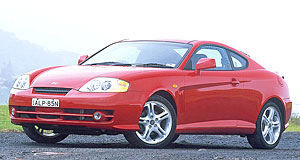First Oz drive: The tempting Tiburon
BY JUSTIN LACY | 15th Mar 2002

Although even Hyundai still considers itself a second tier manufacturer behind the Australian, European and mainstream Japanese marques, over the last half decade it has consistently been the top selling brand after Australia's Big Four - Holden, Ford, Toyota and Mitsubishi.
Now it is looking to the Tiburon to be an image car for the brand, one that has traditionally been linked to driveaway pricing and volume selling.
The South Korean marque claims its research shows people view the Tiburon as marking the coming of age of the Hyundai brand.
During unbadged market testing for the sports coupe, people generally guessed it to be a Mazda or Honda and sometimes even a Toyota.
Based on that acceptance of the car's design and styling, Hyundai is hoping it will be able to lift the brand's image with a flow-on effect to the rest of the range.
The Tiburon is the latest model in a new product offensive that stretches back over the past 18 months.
In that time Hyundai has expanded its range from four models to nine, but it does not stop there. A new entry level light car called Getz will arrive around September, followed by facelifts of the Accent and Grandeur ranges before the year is out.
Pricing for the Tiburon sports car, which was announced at last month's Melbourne motor show, starts at $35,880 for the manual 2.0-litre, then $38,380 for the 2.0 Selectronic automatic, $41,880 for the 2.7-litre V6 six-speed manual and $42,880 for the V6 Selectronic auto.
That makes the range topping V6 auto the most expensive model in Hyundai's passenger car line-up, taking over from the Grandeur XG. Only the Terracan Highlander medium four-wheel drive costs more than the Tiburon within Hyundai's complete vehicle range.
The prices also represent an increase of over 30 per cent on the Tiburon's predecessor, the Coupe SX and FX models. It is a substantial change for the South Korean marque to go from having an entry level sports car with a cost advantage to one that is priced much closer to its competitors.
The Tiburon is based on a shortened Elantra platform, just as its RD-series Coupe successor came off Lantra underpinnings.
Two models make up the range, Tiburon and Tiburon V6, which between them offer a choice of two engines and three transmissions, but just one trim level.
The "Beta" series 2.0-litre, four-cylinder engine is the base powerplant for Tiburon after Hyundai decided to drop the 1.8-litre unit used in the now superseded Coupe SX.
The 2.0-litre was previously available in the top-spec Coupe FX, but in Tiburon guise it picks up the raft of engineering changes that occurred with the Elantra upgrade to produce 102kW of power at 4500rpm and 181Nm peak torque, also at 4500rpm.
It is matched to either a five-speed manual or the new four-speed Selectronic sequential automatic transmission.
The "Delta" series 2.7-litre, all-alloy V6 engine in the high-grade Tiburon also finds a home under the bonnet of the Sonata, Santa Fe and Trajet models.
For the Tiburon, it develops 127kW of power at 6000rpm and 245Nm of torque at 4000rpm and is mated to either the Selectronic auto or Hyundai's first six-speed manual transmission, which is manufactured by an outside Japanese supplier and can also be found in Nissan and Toyota products.
The close ratio unit has a 26mm shorter gear lever as well as a 38mm shorter throw than the gearbox in the superseded Coupe, which are figures that also apply to the base Tiburon's five-speed manual transmission.
Hyundai's German Technical Centre was responsible for tuning the Tiburon's all-independent suspension - MacPherson strut at the front and a multi-link set-up at the rear - which is why the car comes specified with Sachs gas dampers on all corners.
Tiburon is bigger in every dimension than the car it replaces, which means kerb mass has also gone up by around 116kg, while changes to the steering have meant less turns lock to lock (2.6) but a larger turning circle (10.8m, up from 10.3m).
Styling is a fresh design, although traces of the previous Coupe can still be seen, while other cues cover the automotive spectrum from Audi TT and Ferrari to Ford's Mustang and Cougar, and even the Nissan Z cars.
Wheels and tyres are the biggest ever fitted to a Hyundai, with the alloy wheels measuring 16-inches on the Tiburon and 17-inches on the V6. Both wheel designs are mounted on low profile tyres, measuring 205/55 and 215/45 respectively.
Standard equipment levels are high with all models featuring dual front airbags, air-conditioning, six-speaker audio system with CD player, electric windows and mirrors, remote central locking with alarm, trip computer, four wheel disc brakes, front foglights and intermittent windscreen wipers.
The V6 model adds ABS with Electronic Brake force Distribution (EBD), cruise control, leather steering wheel and gear knob, and a rear spoiler.
Hyundai expects at-launch sales to be in the order of 100-150 units per month, with an ongoing rate after the initial demand of 50-100 units per month.
The V6 models are expected to account for a higher percentage of Tiburon sales, settling at around 60 per cent of total volume after a 70 per cent initial demand rate.
PRICING:
Tiburon $35,880
Tiburon auto $38,380
Tiburon V6 $41,880
Tiburon V6 auto $42,880